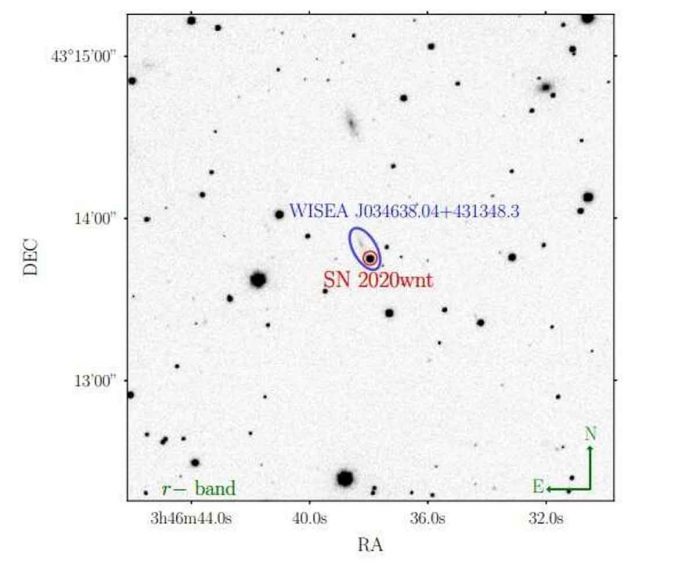An international team of astronomers examined SN 2020wnt, an unusual superluminous supernova. According to the study’s findings, this supernova is slowly evolving and carbon-rich. The discovery was detailed in a paper published on the arXiv pre-print server on June 3. Supernovae (SNe) are luminous and powerful stellar explosions. They are significant to the scientific community because they provide crucial information about the evolution of stars and galaxies. SNe is classified into two types based on their atomic spectra: Type I and Type II. Type I SNe have no hydrogen in their spectra, whereas Type II SNe has hydrogen spectral lines.
Superluminous supernovae (SLSNe) have extremely bright, often long-lived light curves. The interaction of SN ejecta with surrounding circumstellar material (CSM) is an efficient mechanism for converting ejecta kinetic energy into radiation, and it is assumed that such a process may power SLSNe.
The Zwicky Transient Facility (ZTF) detected SN 2020wnt (also known as ZTF20acjeflr and ATLAS20beko) on October 14, 2020, at a magnitude of 19.7. Following observations of SN 2020wnt, it was determined to be a Type I supernova with a redshift of 0.032. WISEA J034638.04+431348.3 is the faint galaxy that hosts this SN.
A group of astronomers led by Claudia Gutiérrez of Finland’s University of Turku has now presented the results of new observations of SN 2020wnt that shed more light on the supernova’s properties. The majority of these observations were made by two wide-field imaging surveys: ATLAS (Asteroid Terrestrial Impact Last Alert System) and Zwicky Transient Facility (ZTF).
According to the new findings, the light curves of SN 2020wnt show an early bump lasting about five days, followed by a slow rise to the main peak. It was also noted that the peak occurs at different times, occurring faster in the bluer bands, and that the peak absolute magnitude of around 20.5 mag was recorded 77 days after the explosion.
Furthermore, the light curves show a linear decline in all bands about 130 days after the explosion. Later, on the 273rd day after the explosion, there is a sudden drop in brightness, indicating a significant leakage of gamma-ray photons. Gutiérrez’s team’s most recent observation, which began 350 days after the explosion, shows an increase in brightness, indicating an interaction between the ejecta and the circumstellar medium (CSM).
The researchers also discovered that the optical spectra of SN 2020wnt show distinct lines of ionized carbon (C II) and silicon (Si II), but not the classical oxygen (O II) lines that characterize Type I SLSNe. This was most likely due to the SN’s low temperatures (below 10,000 K).
As a result, the paper’s authors concluded that SN 2020wnt is a slowly evolving carbon-rich SLSN. They estimate that the progenitor of this SN had a mass of about 80 solar masses, a radius of about 15 solar radii, and an explosive energy of about 45 sexdecillion ergs.

